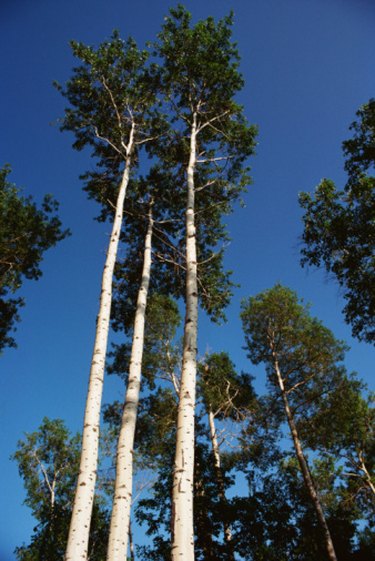
Aspen, poplars and cottonwoods all belong to the genus Populus of the willow family. Some poplars are among most cold-hardy trees, growing in U.S. Department of Agriculture plant hardiness zones 1 and 2, where winter lows reach minus 50 degrees Fahrenheit. Ironically, some of the better poplars for your landscape are non-native species from Europe, with more attractive features than the natives possess.
Types and Geography
Video of the Day
The white poplar (Populus alba) is an introduced European native, but since colonial times has become part of the landscape of southern Canada and much of the United States. The balsam poplar (Populus balsamifera) is the northernmost of all hardwood trees in the western hemisphere, notes the "National Audubon Society Field Guide to Trees: Eastern Region." It grows from northwestern Alaska into the Great Lake States. Eastern cottonwood (Populus deltoids) has a range from west central Canada south to Mexico and throughout most of the East. Quaking aspen (Populus tremuloides) grows from Alaska to Newfoundland and southward into the Rocky Mountains and portions of the East. Bigtooth aspen (Populus grandidentata) is a species of the Northeast and Great Lakes into southern Canada.
Video of the Day
Size
White poplar grows between 50 and 75 feet tall on average. Balsam poplar matures to between 60 and 80 feet. Eastern cottonwood is a potentially massive specimen, growing sometimes well over 100 feet, with trunks as wide as 4 feet. Quaking aspen has a much smaller trunk at up to 18 inches, with heights of this poplar reaching between 40 and 50 feet. Bigtooth aspen grows from 50 to 70 feet high. The Lombardy poplar (Populus nigra) grows to 60 feet but is much narrower than other poplars, with widths of just 10 feet.
Features
Poplar foliage is among the tree's best feature. The leaves are normally almost as wide as they are long, with rounded or triangular shapes. The leaves have noticeable serrations on their borders, are shades of green and grow on long stalks that allow them to flutter in the breeze. In fall, most forms of poplar change to shades of yellow. The inconspicuous flowers of the poplars yield cottony seeds with tiny tufts of attached hairs.
Pros and Cons
The white poplar has perhaps the best ornamental value of the poplars because of the whitish color of the foliage undersides. Poplars grow quickly, making them potential screens and windbreaks. Planting poplars in naturalized areas helps control erosion. They possess weak wood, making them a hazard on lawns and near structures when branches break off in storms. None of the poplars works well as a street tree, since their shallow roots can buckle pavement and sidewalks, and poplars are messy, dropping leaves, twigs and their cottony seeds. Poplars are subject to a host of ailments, including leaf dieback, powdery mildew and trunk cankers.